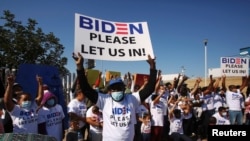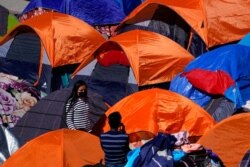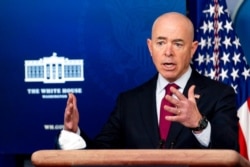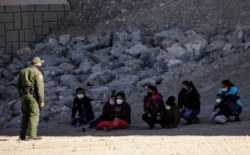On the day U.S. President Joe Biden took office, he began dismantling former President Donald Trump’s policies at the southern U.S.-Mexico border.
Biden rescinded Trump’s declaration of a national emergency, suspended construction of Trump’s controversial border wall, and vowed to end governmental practices of migrant family separation and rapid-fire deportations.
The abrupt shift in policy almost overnight changed conditions and migrant expectations along the border – renewing hope for hundreds of thousands of migrants from Mexico and Central America of a return to more porous borders and pathways to legal status. But it also raised the concern of law enforcement officials and residents about a return of caravans, chaos and potential for violence.
Border policy changes accelerated dramatically this week as reports surfaced the Biden administration intends to release most parents and children seeking asylum within 72 hours of their arrival in the U.S. Rapid processing would include COVID-19 testing and criminal background checks.
The new policy marks a dramatic shift from Trump and Obama administration protocols where families could be detained for up to 21 days. The change is likely to spur even more arrivals of unaccompanied minors and migrant families this year, according to a senior Immigration and Customs Enforcement official.
Still in place, however, is a Trump administration policy that cites the coronavirus pandemic and public health as a reason to deport migrants attempting to enter the country at the border without due process.
Children attempting to cross the border by themselves had been the exception. They can only be detained by U.S. Customs and Border Protection for up to three days before another agency looks for a sponsor for the child while awaiting immigration proceedings.
Rising numbers at border
On March 1, Department of Homeland Security Secretary Alejandro Mayorkas sought to assure reporters that there was no crisis at the border, just “challenges that we are managing” with existing resources.
But the reality on the ground is quite different from the optimistic picture Mayorkas was painting.
The number of people attempting to cross the border has steadily increased since April 2020. U.S. Customs and Border Protection officials say worsening economic conditions in Central and South America, exacerbated by the pandemic and natural disasters, are some of the factors that lead people to make the dangerous trip.
Border Angels, the San Diego-based humanitarian organization, reports an increase of families from Mexico migrating north due to drug cartel activity. Central Americans, Haitians and people from African countries are also seeking asylum in the U.S.
Asylum-seekers who desire to enter the U.S. “need to wait. It takes time to rebuild the system from scratch,” Mayorkas said, telling reporters at a White House press briefing that under the Trump administration, the immigration system had been “gutted.”
In January 2021, CPB officers encountered close to 7,500 families attempting to cross into the U.S., compared to just over 4,700 in October 2020. The number of children and single adults arrested for crossing has also increased.
In late February, in the Rio Grande Valley sector of Texas, Chief Patrol Agent Brian Hastings posted on Twitter that more than 500 people, consisting mostly of families and unaccompanied children, tried to cross the border in a 24-hour period.
The level of border apprehensions is not unprecedented. Border Patrol reported apprehending more than 47,000 migrants along the U.S.-Mexico border for the month of January 2019. More than 44,000 were intercepted in January 2009.
‘Remain in Mexico’ asylum-seekers
The changes in U.S. immigration policy are being closely watched by another group of migrants who have been forced to stay in Mexico under Trump's Migrant Protection Protocols (MPP). This is also known as the "Remain in Mexico" policy, which allowed border patrol agents to return non-Mexican asylum-seekers to Mexico to wait for their cases to be reviewed and processed.
The rapid-fire changes in immigration policy under the new administration have been confusing to some of the MPP asylum-seekers. Dulce Garcia, executive director of Border Angels, which supports 15 shelters in Mexico for asylum-seekers waiting to have their cases heard in the U.S., says half of a shelter's residents recently set out to try their luck at the border.
“About a quarter came back after being rejected,” she said, “and the other quarter is what is really concerning to us, because we think that maybe they are trying (to cross the border) through the desert.”
U.S. officials have been working with humanitarian organizations to begin processing the approximately 25,000 people in the MPP program. Beginning February 19, the first group of 25 people who had been waiting in Mexico entered the U.S. in San Diego, California. Mayorkas said officials are increasing the number of ports that are processing asylum-seekers as well as the number of people being processed.
“From what we see, in what their policies suggest is a much more humane and protection-focused policy. This includes recognition of various forms of persecution, recognizing things such as gang violence and domestic violence,” said Ellen Beattie, senior director of program quality and innovation at the International Rescue Committee.
A task force is working on reuniting families separated under the Trump administration. If the families reunite in the U.S., the Biden administration is exploring lawful pathways for them to remain in the country.
Other than asylum-seekers
While agents are seeing an increase of families and unaccompanied children attempting to cross or being smuggled across the border, they also see more serious criminal activity.
Border patrol agents said a combination of a border wall, manpower and technology will help them to do their jobs.
In February alone, agents in the Texas Rio Grande Sector have uncovered hundreds of pounds of drugs, such as cocaine, as well as arrested convicted sex offenders trying to reenter the U.S.
Texas rancher Chloe Wilson has seen a “significant increase in traffic” in the area where she lives in Southwest Texas more than 100 kilometers from the U.S.-Mexico border, as well as on her family’s properties near the border.
“These are criminals that are hauling drugs, people and children. These are not good people that are coming across. They’re in full military fatigues and work boots. These people are prepared. It’s not just people seeking asylum. It’s men carrying cocaine and marijuana. We see them during the day and throughout the night,” said Wilson, who added she had witnessed mainly men with backpacks and guns.
She said criminal elements from south of the Texas border are not limited to the border areas but are traveling deep into Texas.
The right time
Mayra Flores, a U.S. citizen originally from Mexico, is the wife of a border patrol agent. She sees the increase in migrants trying to cross the border and fears for the border patrol agents as well as her community in South Texas.
She says the cartels profit from smuggling people across the border and endanger migrants trying to cross.
“Cameron County and Hidalgo County (Texas), we have one of the highest poverty rates in the United States … they don’t have the resources” to absorb the new migrants at a time when many places in the U.S. are still facing unemployment rates due to the coronavirus, Flores said.
“We need to decrease the COVID-19 situation here in South Texas,” said Flores, who has decided to run for U.S. Congress. “It’s putting our border patrol agents at risk, it’s putting everyone at risk. It’s putting our community at risk.”
Department of Homeland Security said asylum-seekers are being tested for COVID-19 before they are allowed to enter the U.S. However, news outlet Noticias Telemundo Investiga reported some migrants in Brownsville, Texas, who were planning to travel to other parts of the country, had tested positive for COVID-19 after being released by Border Patrol.
“No time is a good time for an asylum-seeker,” said Vino Pajanor, chief executive director of Catholic Charities Diocese of San Diego.
“During COVID, it is tough. Yes, many of us and our fellow colleagues and fellow countrymen have lost their jobs, but that doesn’t mean that we have to shut ourselves and say we’re not going to give you hope,” Pajanor said, referring to the people seeking asylum in the U.S.













